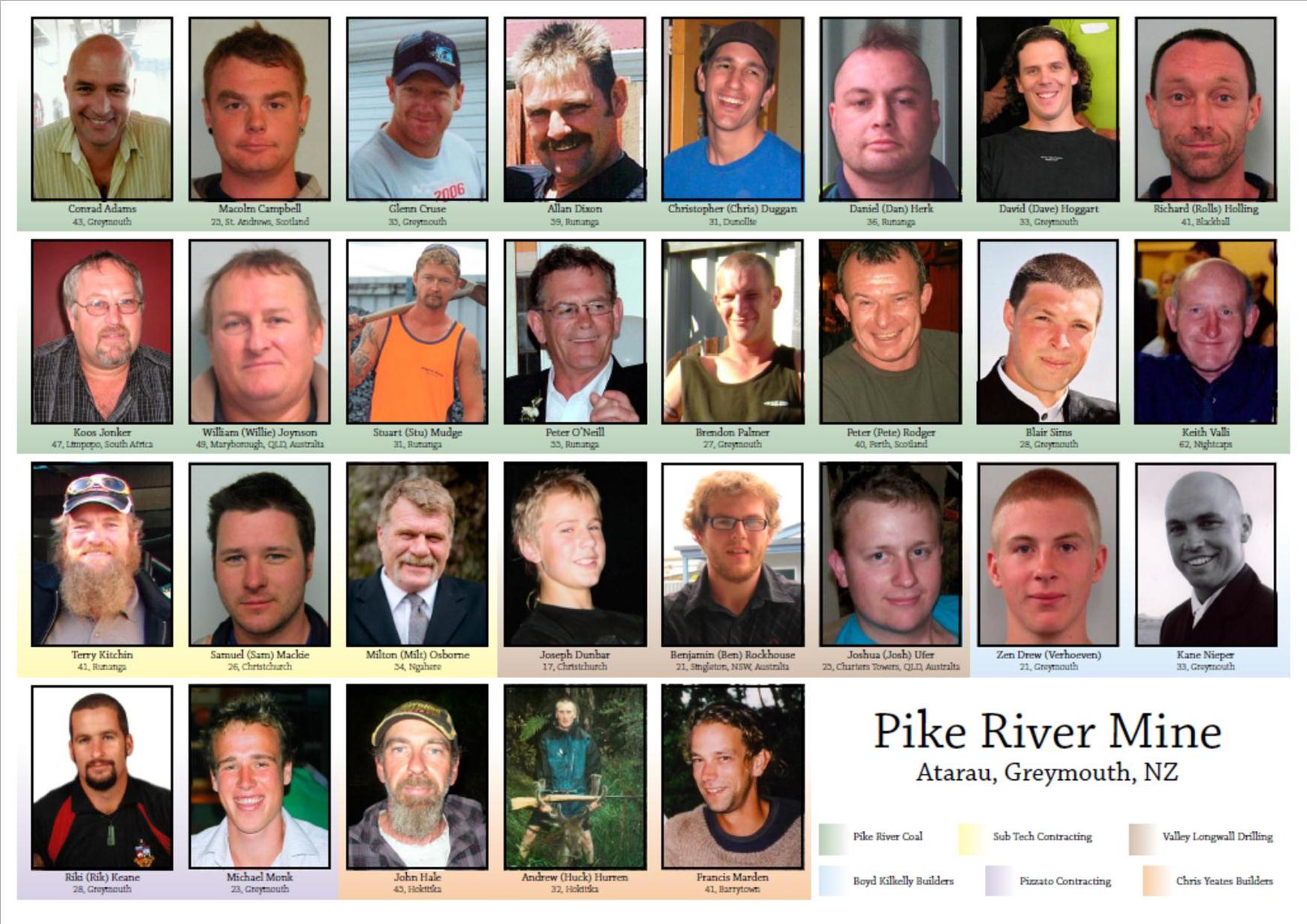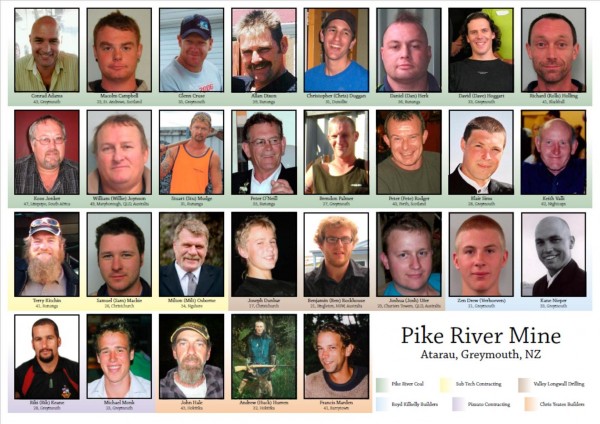The past is never dead, it’s not even past.
Wm Faulkner
On November 19, 2010, twenty-nine men died in an explosion at the Pike River Mine. Immediately after the accident the Prime Minister comforted those who lost their fathers, brothers, husbands and sons saying that the nation stood along side them in their grief. We, the Nation, would discover the reasons why this event had occurred and ensure that it would not ever happen again.
Ten days later a Royal Commission of Inquiry (referred to as the Commission) was established. The Commission spent over a year and $10.5 million dollars investigating. Hundreds of people were interviewed, tens of thousands of documents were collected and 48 days of hearings were held. On October 30, 2012, the Commission’s Report was released to the Government.
Well received at the time of its release, the Report offered a damning description of the events at the Pike River mine. Pike River Coal Mine was, the Commission found, focused on short term production and did not manage the risks of the operation. The Commission confirmed what many people already believed, that quite simply the company put profits ahead of safety.
The Commission’s conclusions and recommendations satisfied the government and seemingly most everyone involved. The Commission did not, however, discover why the disaster occurred. The men died because the mine exploded, but the Commission was unable to determine why the mine exploded. The Commission offered a number of possible scenarios ranging from equipment malfunction to the use of contraband. It was not, however, possible to narrow the possibilities as the mine was not re-entered. Without a scene examination, the Commission could only speculate as to why the methane gasses accumulated to an explosive level and then exploded.
The failure to re-enter the mine also meant that the bodies of the workers killed in the explosion were to lie where they fell. This was hard for the families of the deceased to accept. While most conceded that in the days or months following the disaster re-entry was too dangerous to re-enter as time went on family members became increasingly frustrated with the refusal to fund re-entry. In 2012 the Pike River Coal Mine was sold to the government owned coal company, Solid Energy, with the understanding that if the mine were to re-open the mine, then the bodies would be recovered.
In May 2012 the families were told that “the prospects of body recovery were remote” given the dangers in re-entering the mine. At the same time, there was also increasing concern that it was not a matter of safety as much as a matter of cost. Overseas mining experts consulted by some of the families developed a plan for re-entry and eventually funds were committed to do work to investigate re-entry. In late 2014 after spending a further $5.2 million on the re-entry project, the Government advised the re-entry plan was to be abandoned. Instead monies were made available to create a park and walking trail near the mine head.
Without re-entry and forensic evidence as to the cause of the explosion, it was also not possible to establish that the company or any of its officers were either negligent or criminally liable for any act or omission. In 2012 charges were laid against Pike River Coal Mine, the former and bankrupt owners of the Pike River Mine as well as the former chief executive, Peter Whittall. At the opening of their trial, the Company’s lawyers advised that they would not defend the charges, but would attend sentencing. In its decision, the court found the company guilty and ordered it to pay $3.41 million – $110,000 for each family of the victims and for the two survivors. The Company submitted at sentencing that while it had $2 million worth of liability insurance, after legal fees were paid, only $156,000 or around $5,000 for each family, remained. The charges against Peter Whittall were eventually dropped in December 2013. Mr. Whittall’s lawyer was reported as stating that he had concerns with the prosecution’s case as it included “unsigned briefs of evidence, briefs of evidence that contained hearsay quotations, inadmissible opinion evidence, submissions and conclusions of matters of law, assumed and misstated facts, and speculative conclusions”. [Accessed May 6, 2014 ] However, Mr. Whittal did agree to pay $3.4 million in reparations, which the Company was unable to pay. [Accessed May 26, 2015 ]
Five years on the story of Pike River Coal Mine remains unfinished. Of course an end to the story is difficult as no one can say for sure why the mine blew up when it did. The Company likely put profits ahead of safety, but just as there was no re-entry of the mine, there was no forensic audit of the Company. The Government acted quickly in setting up a Royal Commission of Inquiry but it is unclear as to what extent the company and its officers were investigated with respect to their financial management of the Pike River project. The Commission was tasked with determining the cause of the explosion, but this did not, it seemed, extend to investigating financial issues, such as whether the prospectus issued by the Company were based on fact. The Commission also accepted that the mine could not be re-entered, but it is unclear as to whether the feasibility or costs of doing were investigated, notwithstanding the fact that the failure to re-enter the mine meant that they would be unable to complete their assigned task – determining why the mine exploded. Questions as to whether there might have been any financial malfeasance or professional negligence with regard to the mine design and development, if noted, were not discussed. Despite or perhaps because of the lack of forensic evidence, the Commission concluded that the ultimate cause of the disaster was the failure of Pike River Coal Mine’s health and safety management system. But if the system was to blame, does this mean that no one was responsible? The Minister of Labour did resign and the Government accepted most of the Commission’s recommendations for Occupational Health and Safety reform but this hardly provide all the answers a good ending requires.
The story of the Pike River Mine deserves an ending – something more than the sense that 29 men died, that the mine is now sealed. Peter McEwen offers an ending in his book Death by Parliament in part by laying blame for the tragedy at the feet of the politicians who disbanded the mine inspectorate. But with such an ending the question which then must be asked is what must politicians do now to ensure that another such a tragedy does not occur again in 5, 10 or 20 years. While better and more strictly enforced occupational health and safety regulations may have prevented the Pike River Mine tragedy, what is needed is an acknowledgement the project should never have been undertaken in the first place and with this, discussion as to the role of government in such projects. There should have been better scrutiny of the proposal, the designs and the financing of the project long before the ground was broken at Pike River – but who should have done that? And with other similarly risky projects such as deep ocean mining exploration, who should be responsible to ensure that tragedy, whether human or environmental do not occur.
All we have is the Commission’s Report and many unanswered questions – an unfinished story.
Nadine worked for trade unions in Canada doing compensation and employment law for a number of years. At present she is a Auckland based senior researcher associated with the Centre for Occupational Health and Safety at AUT.







The Pike River tragedy is a tragedy that just makes me want to shout; SHAME, SHAME, SHAME at the government, and company involved.
From what I saw of Pike River the service lines where hung low, ventilation management was poor which was exacerbated by a raising decline. As far as I’m aware these where rules set by OH&S or outlined in the lease contract because DOC didn’t want any new roads built through its park, which meant delays in bringing there new vent fan online.
If you have a problem, you solve it, because over coming Gravity is a huge problem, worrying about bean counters or mines inspectors is a wast of time. Quite simply, it is impossible to engineer a safe mine.
I think Mark Twain said it best when he described a miner as a hole in the ground with a liar standing next to it.
Yep mining is dangerous. But in the case of Pike River, because of neglect and greed, the danger was ramped up to levels that made disaster almost inevitable. Analysis of mining disasters in this country (and elsewhere) show that disasters have always been most prevalent when unions have been weakened and government regulation and enforcement have been tardy. It is no coincident that 100 years seperate the tragedy of Ralphs Mine (1914) and the next really big event at Pike River.
The narrative blaming mine tragedy on those who die is an old one. It is the same narrative that the owners of Ralph’s Mine tried to build when they attempted to hide their own culpability for the death of the 42 incinerated in an unsafe mine. It’s an argument that is as sickening and vile now as it was then.
Three things:
1) every one is responsible for safety
2) great mates make great teams, nothing else matters, not money, production targets, teams like this can’t help but win
3) I’m a miner
Have a good day
Thank you Nadine and TDB for headlining this fifth anniversary of the Pike River mine disaster. The 29 miners who died, deserve to be remembered, as do their families and colleagues.
This is something which should be headline news in msm, if for nothing else, out of respect for the dead miners and their families and to remind us of the unnecessary tragedy five years on, with all the cover ups, lying and buck passing involved which followed.
But it’s not headline news in msm.
That is reserved for a recently deceased rugby player. Says it all about the misguided culture of msn and to an extent, the culture of NZ!
RIP Pike River 29. For some of us, your memory will be held strong.
Good article.
We write a bunch of pieces about it over on Redline. They are collected here: http://www.nziff.co.nz/2015/christchurch/the-women-of-pike-river/
The doco ‘The Women of Pike River’ on Tuesday was very moving. One of the most telling things for me was Key’s behaviour. He couldn’t get there quick enough in Nov 2010, full of promises. Then the promises all turned out to be shallow, and he begins avoiding the families.
So when he was in Greymouth electioneering in August 24 and a bunch of family members are standing with placards outside where he’s speaking, he makes a minute or two to go over and chat rather awkwardly.
Then a few months later, when he’s back in Greymouth speaking at something, and they’re outside the building with placards, he just gets out of the prime ministerial car and straight into the building – doesn’t even make eye contact with them, and when he comes out, it’s the same, straight into the car, not even eye contact. What a weasel the dude is.
Labour, of course, is not keen to make a fuss because they were the government that singed off on the mine and they are as responsible as national for the lack of mine inspectors. Plus Little, as head of the EPMU, said the mine was fine.
If we had a *real* labour movement in this country – ie a real working class mass movement – the killings at Pike River (and let’s call them what they were) would have set off protests from one end of the country to another and everything would have been done to get the bodies out and to hold the company, the successive governments and the relevant union tops responsible.
Sadly, we have a tame, house-trained, union movement, a bunch of politically parties competing to manage the same system – the one that makes things like Pike River happen – and no serious political opposition, as the working class has gone into deep sleep.
Like many others, I followed the proceedings of a mine rescue in Chile. It was an incredible undertaking, and was ultimately successful. After the last man had been pulled out that nightmare, I found myself wondering what would happen if such an event happened here in NZ. I decided that a half-hearted effort would be made, before putting into the “too hard” basket, and calling it quits.
In such matters, I’m not often right, and this was one time that now, I wish I had been wrong. NZ is in danger of becoming (if not there already) the laughing stock of disaster response. We could be held up as an example of how not to do things. The families of the 29 deserve better, as do the people of Greymouth.
We need to get into that mine, we need to bring out those bodies, and we must ensure should anything like that happen again, we are prepared.
Comments are closed.